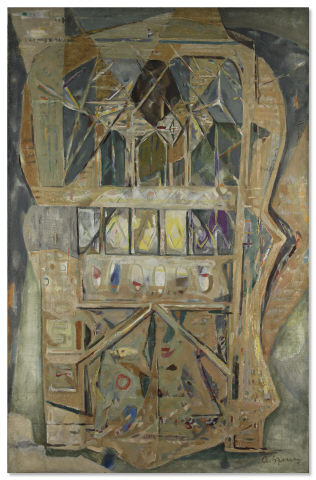
- 1948
- Canvas
- Oil
- Inv. PE87
Arpad Szenes
Marie Hélène
Inseparable in painting and in the life that they shared for over five decades, Arpad Szenes and Maria Helena Vieira da Silva began to paint portraits of one other in 1930 and continued to do so at different points. Arpad drew and painted Maria Helena alone or shown as part of a couple (Le couple series, 1930-35), in a union and fusion of bodies with interior spaces and objects – tables or chairs – in versions which are sometimes figurative and sometimes geometrised. A series of portraits of Vieira da Silva date from the period of exile in Brazil (1940-47). Arpad produced these portraits almost daily of her working, sleeping, in her wicker chair, in a ceaseless dialogue, also in terms of painting. This theme has special symbolism: it represents continuity in the work of Arpad, such as the chair brought from Europe with its curves that frame Vieira da Silva. In contrast to Maria Helena, who disliked her years in Brazil and readjusted well to Paris, the return to France in 1947 represented for Arpad a period of difficult readjustment and great difficulty in painting.
The works from this period expand into variations on another theme, Conversations, resulting from interior, silent and unanswered dialogue. They are “conversations” with a partner who may or may not be Vieira da Silva, who had already been previously represented as absent and focused on her work. These works reflect tension and isolation, and in them Arpad experiments with multiple visual interpretations: the chair acquires a transparency and becomes indistinguishable from the figure, imprisoning the model. In these closed spaces he tries to restore meaning to his work. In search of reconstruction, Arpad also resumes his portraits of Maria Helena in her wicker chair, now purposefully turning her back to us, making any dialogue impossible. The image of Maria Helena is tangible in her absence, entangled in the woven fibres of the chair. It is still the impossibility of communication and solitude which emanate from these portraits, “Maria Helena”, or “Marie-Hélène” in an impossible dialogue with painting.
In this canvas, more than a perfect model, Marie-Hélène becomes the theme and is used for new pictorial exploration: the shapes become more geometric and colour is used in patches which accentuate the form. The sensation of distance and isolation tends to be replaced by the certainty of being on the right path: the Banquets series is the theme which follows and links into this one, as a new metaphor for the portraits of Maria Helena, the couple and the “conversations”. The approximation to more abstract language, the focus of the artist on structure, geometrisation of form and colour, objects which turn into signs, can already be perceived in this Marie-Hélène. This new path of exploration, which has a greater affinity to Arpad Szenes, allows him to depict a new understanding of space, which was previously closed. Therefore the “Banquets” represent a turning point in his artistic journey.
Marina Bairrão Ruivo
May 2010
| Type | Value | Unit | Section |
| Width | 105,3 | cm | |
| Height | 162 | cm | |
| Height | 163,5 | cm | |
| Width | 106,9 | cm | |
| Thickness | 3 | cm |
| Type | signature |
| Type | Donation |
| Inauguração do CAM |
| CAM/FCG |
| Curator: A definir |
| 20 de Julho de 1983 Lisboa, Centro de Arte Moderna/ FCG |
| 20 de Julho 1983. |
| Vieira da Silva - Arpad Szenes nas Colecções portuguesas |
| Casa de Serralves |
| Curator: A definir |
| Fevereiro de 1989 a Abril de 1989 Casa de Serralves, Porto |
| Exposição individual, no Porto, em 1989. |
| Arpad Szenes |
| Fundação Calouste Gulbenkian |
| Curator: A definir |
| Existe um catálogo da exposição. |
| Arpad Szenes |
| Musée d'Art Moderne de la Villle de Paris |
| Curator: A definir |
| Paris, 27 Fevereiro - 21 Abril 1974 |